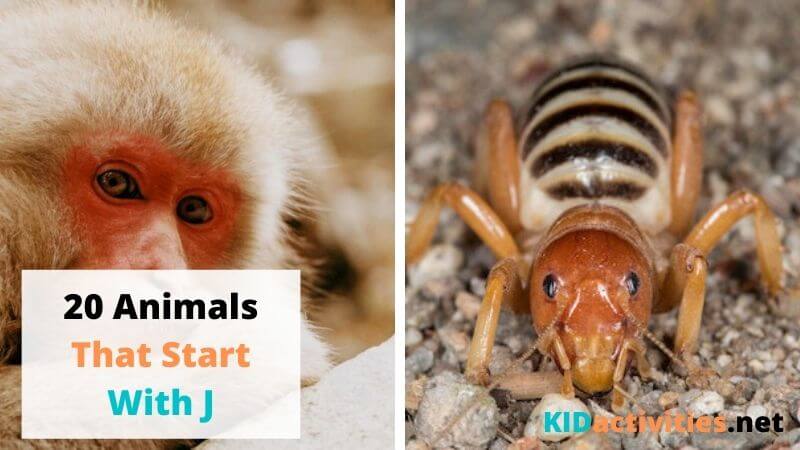Ready to discover 23 of the most captivating animals that start with the letter J?
We will not only provide you with basic information about each one of them but also with interesting facts that will help you discover their most hidden facets. Let’s get down to business!
Let’s get started shall we
23 animals that start with J
1. Jaguar
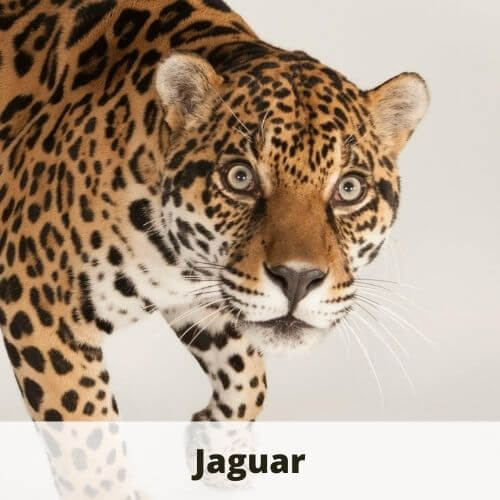
The largest cat species in the Americas and the third-largest cat in the world (after tigers and lions), the jaguar can be found in South, North, and Central America.
Due to illegal trade, human conflict, and habitat loss, jaguars are currently listed as an endangered species.
If jaguars could once be found from south-western USA down to central Argentina, nowadays they are basically restricted to the Amazon basin and Pantanal wetlands.
The origin of their name is ‘yaguar’, an indigenous name meaning ‘he who kills with one leap’. Jaguars usually live 12-15 years in the wild.
Jaguars have short legs, large and round heads, and tan or orange fur with black spots.
The black spots are shaped like roses and are commonly called rosettes. An adult jaguar can weigh up to 113 kilograms and can be 240 cm. long (from nose to tail tip).
Unlike other cat species, jaguars are not afraid of water and are outstanding swimmers.
That’s why jaguars can often be found near lakes, wetlands, and rivers. Jaguars usually live alone. However, they do mark their territories with their urine or by marking the trees with their claws.
The only time jaguars get together with other jaguars is during the mating season.
Jaguars are carnivores and their diet is rich in meat and fish. The most ferocious predators in their habitat, jaguars use their speed to hunt deer, monkeys, peccaries, birds, frogs, lizards, fish, crocodiles, alligators, caimans, tapirs, iguanas, armadillos, etc.
Since its habitat is constantly being destroyed and food can be scarce, jaguars also attack domestic livestock, thus getting in conflict with people and getting killed.
No other cat species has stronger jaws than jaguars! Their jaws can easily break through a turtle’s shell or a crocodile’s skull. Jaguars can crunch down on bones and make them part of their diet.
Interesting facts about Jaguars
- Since they are top predators, jaguars play a crucial role in keeping the food chain balanced.
- At night, their sight is 6 times better than human sight.
- To attract fish, jaguars use their tails as fishing lines and dip them into the water.
- Even though the demand for their skin has decreased considerably, jaguars are still being pursued for their paws and teeth (which are used for ornaments and in traditional medicine).
- Jaguars are often mistaken for leopards. However, there is a way to make the difference: the black dots inside their rosettes. Leopards don’t have them.
- When hunting, jaguars can travel up to 10km.
- Jaguars can take down prey that is 3-4 times bigger than them. Unlike other cats that target the throat or neck, jaguars usually bite the back of the prey’s skull.
2. Jackal

A medium-sized type of canine, jackals are closely related to domestic dogs, wolves, coyotes, and foxes.
Actually, jackals look like a cross between a fox and a German shepherd: small face, fluffy tail, agile legs, and long, pointed ears.
Jackals can live 8-9 years in the wild. In captivity, they can live up to 16 years.
Jackals are omnivorous mammals, feeding mainly on birds, reptiles, other small mammals, insects, fruits, and vegetation.
They are also known to be active scavengers. Jackals are mainly active at dawn, dusk, and night. However, side-striped jackals are strictly nocturnal.
Thanks to their fused leg bones and large feet, jackals are physically adapted for distance running, being able to maintain speeds of 16 km/h.
Jackals usually live in monogamous pairs together with their offspring, though they can sometimes gather in small packs (mainly to make hunting more efficient and take on big prey such as antelopes).
Since they are highly territorial animals, jackals use their feces and urine to mark their territory and fiercely chase away any intruding rival. Jackal pairs hunt, eat, sleep, and defend their territory together.
Their biggest enemies are eagles (especially for pups), hyenas, and leopards.
There are three known species: the golden jackal (common jackal), the black-backed jackal, and the side-striped jackal.
Jackals live primarily in Africa. However, each species lives in a different area.
The black-backed jackal can be found on the African eastern coastline and in southern South Africa. They mainly live in savannas and woodlands.
The side-striped jackal can be found in tropical Africa and it inhabits savannas, marshes, and bushlands.
The golden jackal can be found in south-eastern Europe and East and North Africa. It inhabits arid grasslands, open savannas, and deserts.
Interesting facts about Jackals
- Jackals mate for a lifetime. Both parents take care of the young.
- Most jackal pups are killed by eagles. In order to protect their pups, jackal mothers frequently change their den (once every two weeks). Sometimes, youngsters from the previous litter help their mothers to protect the new generation.
- Each family has its specific yipping sound. Only the members of the respective family will respond to it.
- Since the side-striped jackal can hoot like owls, the people from Uganda also call it “o loo”.
- If the jackal senses that another animal is approaching its meal, it will bury it and eat it after the threat is gone.
- The black-backed jackal is an important vector of rabies, being associated with numerous epidemics.
3. Jackrabbit

Jackrabbits are small mammals closely related to hares and rabbits. Despite their name, jackrabbits aren’t rabbits and they actually belong to the hare group.
Compared with rabbits, their ears and hind legs are longer, they have larger bodies, and they are born covered with fur.
Jackrabbits can be found in western and central North America, inhabiting wastelands, grasslands, pastures, and fields.
Jackrabbits have dark brown fur, black markings on their backs, long and black-tipped ears, and short black and white tails.
Jackrabbits are active at night. They are herbivores, feeding mainly on grass, cacti, sagebrush, grains, roots, buds of fruit trees, winter wheat, etc. They live 1-5 years.
Their biggest enemies are coyotes, bobcats, foxes, wolves, owls, and other large birds of prey (eagles, hawks, etc.)
Jackrabbits have been extensively hunted for their fur and meat. In addition, they are very sensitive to diseases.
These two factors sometimes lead to a drastic reduction of their population. However, jackrabbits are well known for their high reproduction rate.
Females produce several litters each year, each one of them consisting of 1 to 6 babies.
The babies do not require much parental care and they start an independent life soon after they are born.
Interesting Facts about Jackrabbits
- Due to their extraordinary appetite, jackrabbits are often considered pests. Able to consume impressive amounts of food, they can quickly destroy crops.
- Agile and fast, jackrabbits can leap up to 3 meters (10 feet) and run at 64 km/h (40 miles/h). In order to confuse predators and escape, jackrabbits jump in zigzag.
- Their excellent hearing helps jackrabbits detect predators. They use their hind legs to thump the ground and alert other animals. Their eyes are large and placed high on their heads, toward the side. This practically allows them to see 360 degrees, thus spotting predators easily.
- Jackrabbits use ‘forms’ to hide from predators. Forms are shallow underground depressions covered with grass.
- Jackrabbits are mainly solitary. However, they do gather during the mating season and display an unusual “boxing” behaviour: females hit males with their paws to avoid copulation.
- Their large ears have another interesting function: they allow jackrabbits to lose heat and cool their body temperature.
4. Jay

Jays are medium-sized birds belonging to the crow family. Generally colourful and noisy, there are 35-40 species of jays widespread across Eurasia and North America.
Jays are shy woodland inhabitants, rarely flying away from cover. Rather than seeing them, you will know that they are nearby due to their screaming call. Jays build cuplike nests in trees.
Jays are almost omnivorous, feeding on other birds’ eggs, small mammals, insects, seeds, and nuts.
They are famous for burying acorns that they will eat in the winter. Due to this behaviour, jays play a crucial role in oak trees dispersal. In a season, one jay can hide up to 5.000 acorns.
Interesting facts about Jays
- Jays love to alight on ant nests and let ants crawl on their feathers. This behaviour is called ‘anting’. While this behaviour is still a mystery, it is believed that the ants’ formic acid may remove parasites and act as an antiseptic.
- Jays are able to mimic other birds and animals. When in danger, they can imitate the calls of owls, sparrow hawks, or domestic cats.
- In the 19th century, jays’ blue wing feathers were a much-coveted fashion accessory. As a matter of fact, the Duchess of Edinburgh, Maria Alexandrovna, owned a muff made completely from jay feathers.
- In American slang, the word jay refers to a person who chatters senselessly.
5. Jellyfish

Jellyfish are among the most ancient animals on Earth, even pre-dating dinosaurs! Since jellyfish have no bones, finding fossils is rather impossible.
However, scientists could come across evidence that proves that jellyfish have been around for over 500 million years.
Jellyfish belongs to the Cnidaria family and there are over 10,000 species across the globe’s oceans.
Jellyfish live in both cold and warm water. While some jellyfish are clear, some others have vibrant colours and can even be bioluminescent (i.e. produce their own light).
Despite their name, jellyfish aren’t actually fish. They are invertebrates, have no brain, heart, or eyes, and could be referred to as “gelatinous zooplankton.” Their tentacles are armed with small, stinging cells that they use to paralyse their prey and defend themselves.
Jellyfish are plankton. Since they are not good swimmers, they depend on the ocean’s currents.
When two currents meet, impressive jellyfish blooms can form. Onshore breezes can cause thousands of jellyfish to end up on beaches.
Most jellyfish live around one year. But there are small species that only live a few days.
Jellyfish mainly feed on small plants (phytoplankton), fish eggs, copepods, and fish at young stages (larvae).
However, some jellyfish eat other jellyfish! The jellyfish’s mouth is located in the centre of its body and has three functions: eat, discard waste, and help jellyfish propel by squirting water jets.
On a positive note, jellyfish play a crucial role in the ocean. Apart from being food for marine animals such as turtles and bigger fish, they use their stinging cells to defend small fish against predators.
What’s more, jellyfish make a delicious meal for humans too, especially in China where they are considered a delicacy. Jellyfish are also used in Chinese medicine.
Interesting facts about the Jellyfish
- Young crabs thumb on jellyfish’s back to avoid swimming.
- Jellyfish need to digest food rapidly. Otherwise, they would be weighed down by the undigested food and wouldn’t be able to float.
- Despite the human activities – overfishing, ocean acidification, etc. – that constantly disrupt ecosystems, jellyfish seem to be immune and thrive.
- A jellyfish’s body is made up of 98% water. When a jellyfish ends up on the shore, its body will evaporate in a matter of hours.
- Box jellyfish species do have eyes and some species have surprisingly complex vision (some can even see in colour with a full 360-degree view!) Unfortunately, they are extremely venomous.
- Turritopsis nutricula, a species of jellyfish, is able to renew its organism’s cells when threatened. This basically means that this jellyfish has found the secret to immortality!
- We already know that jellyfish use their stinging tentacles to defend themselves. However, the stinging power depends on the species. Among the most venomous creatures in the world, the box jellyfish can kill an adult human in a couple of minutes. And it only takes one single sting! One box jellyfish could kill over 60 humans with the venom it carries! Scientists believe that the pain is so strong that it might kill a person before the venom does.
- Jellyfish vary in size. Some are so small that they are basically invisible. The smallest species’ bell disk ranges between 0.5 mm to a few mm. The longest jellyfish (the lion’s mane jellyfish) has tentacles that can extend to 37m. The Nomura’s jellyfish is probably the largest species by weight and diameter. Their bell disk can reach up to 2m and it can weigh up to 200 kg.
6. Jabiru
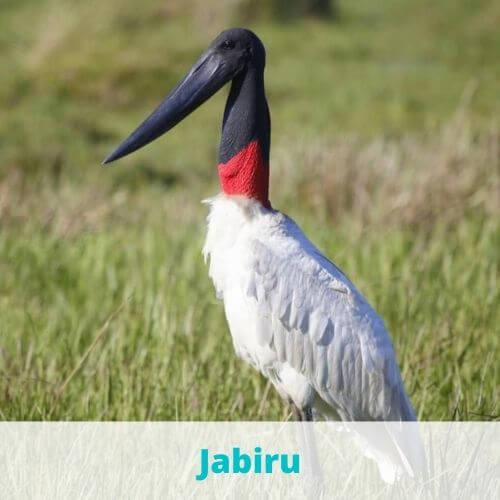
The only members of the Jabiru genus, Jabirus are large storks that can be found in South America, especially in the Pantanal region (Brazil) and Eastern Chaco (Paraguay).
In the Tupi-Guaraní language, their name means “swollen neck”. They are the tallest flying birds in the Americas.
As an adult, the Jabiru can be up to 1.5 m (5 ft) tall and weigh up to 8 kg (17.6 lbs).
Across the wings, it can reach up to 2.8 m (9.2 ft). Its beak is black, broad, and slightly up-turned and it can reach up to 30 cm (1 foot) long.
With a mainly white plumage, jabirus have black, featherless head and upper neck. At the base of the neck, they have a red, featherless, and flexible pouch. Usually, females are smaller than males.
Jabirus live in large groups and can be found near rivers, ponds, marshes, coastal lagoons.
They prefer wetlands and riparian habitats in tropical rainforests. Their diet includes amphibians, mollusks, fish, small mammals, insects, and reptiles (mainly snakes and frogs).
Since they also feed on carrion and dead fish, Jabirus actively participate in maintaining the water quality and preventing the spread of diseases.
Interesting facts about Jabirus
- Despite their size, Jabirus are graceful fliers.
- Jabirus are mainly monogamous. The male uses sticks to build a nest 15-30m up on a tall tree. It is then approached by the female. Season after season, the nest is enlarged up to several meters in diameter. The female lays 3-4 eggs and both parents participate in the incubation process.
- When swimming, the Jabiru’s neck can be easily confused with a snake!
- Now a protected species, Jabirus used to be hunted for their feathers and meat. Nowadays, they make an amazing tourist attraction.
7. Jaguarundi
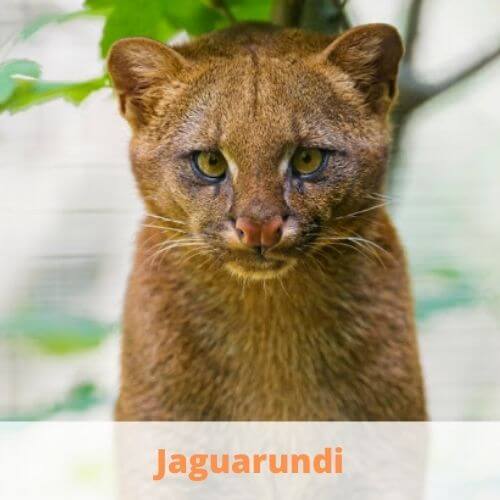
Jaguarundis are usual cats that can be found in South and Central America, Northern Mexico, and possibly in Florida and Texas.
Compared to cats, the jaguarundi has a long and slender body, shorter legs, a small and flat head, and short rounded ears, resembling more a weasel.
Even though little is known about their lifespan in the wild, jaguarundis live up to 15 years in captivity.
Also known as ‘otter-cats’, Jaguarundis are closely related to pumas. As far as their colour is concerned, there are two main groups: a dark morph (with black, brownish, and grey tones) and a pale red morph (with tawny yellow and bright chestnut red tones).
While both colours can occur in one litter, the dark morph tends to be common in rainforest habitats while the pale morph is more common in dry environments.
Commonly inhabiting lowlands, Jaguarundis live in open and closed habitats alike: dry scrubs, swamps, primary forests, savannah, and other environments with dense ground vegetation.
Jaguarundis are mainly solitary, traveling and foraging in pairs. They feed mainly on small rodents, frogs, reptiles, fish (stranded in puddles), rabbits, quails, wild turkeys, and even domestic poultry.
Even though they are excellent swimmers and climbers, Jaguarundis spend most of their time on the ground and are active mainly in the daytime.
The number of jaguarundis has been constantly declining due to habitat loss, deforestation, and the continuous expansion of human structures.
Because they feed on domestic poultry, Jaguarundis are also hunted by farmers. What’s more, they also become the victims of traps that are laid for other animals.
Interesting facts about Jaguarundi
- The Jaguarundi male mates with several females. But the interesting fact is that he has exclusive mating rights over them. They use hollow logs or dense thickets to build dens for their young. A litter consists of 1-4 kittens.
- Unlike other cats, Jaguarundis don’t have spots.
- Jaguarundis are very vocal and boast over 13 distinct calls.
- Jaguarundis can jump as high as 2 m to catch birds flying in the air!
- Even though they are not native to south-eastern U.S., Florida might be hosting a wild Jaguarundis population introduced in 1940. Early Central American natives used to tame them and use them to control the rodent population around their villages.
8. Jerboa
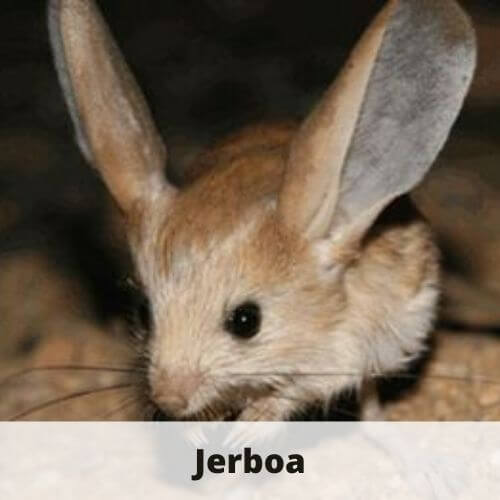
Jerboas are small mammals that are part of the jumping rodents group. They can be found in North Africa and Asia, inhabiting hot and cold deserts. There are more than 30 known species of jerboas.
Their size and colour depend on each species. To provide camouflage, the colour of the fur matches the environment.
While the fur is generally beige, brown, or yellow, their tails end with white tufts.
Their fur is long, silky, and soft. Jerboas resemble mice. They have large eyes, whiskers, and – depending on the habitat – they have small or very large ears.
What makes these cute creatures stand out are their feet: their hind feet are 4 times longer than their front feet, thus allowing them to leap up to 1m.
When in danger, jerboas will leap in a zigzag to confuse predators. In order to move easily across the sand, their pads are furry.
Their ability to hop large distances allows them to undertake long journeys and forage across the desert. Their long tails add balance.
Jerboas live in burrows. To avoid overheating or cooling, jerboas use sand to plug the burrow’s entrance.
They build four separate burrows: two permanent ones (as their winter and summer homes) and two temporary ones.
They use the temporary burrows – which are not camouflaged nor sealed – to escape predators. These burrows are only 10-20 cm deep.
In exchange, their permanent burrows are sealed with sand, well-hidden, and deeper (20-50 cm deep). They use their permanent summer burrows to raise their pups.
In order to escape the high temperatures, jerboas are active mainly at night.
Depending on the species, jerboas may feed solely on plants or combine plants and insects.
Generally, jerboas are shy and solitary, gathering mainly during the mating season.
Their biggest enemies are snakes, jackals, cats, foxes, and owls. In addition, they are also under serious threat due to habitat loss caused by human activity. To avoid the destruction of their crops, farmers often kill jerboas.
Depending on the species, jerboas live 2-6 years in the wild.
Interesting Facts about Jerboas
- Jerboas have hair in the ears and skin flaps in their noses. And for a good reason: keep sand out!
- Jerboas boast excellent hearing and smell. This allows them to find food and detect potential threats.
- Young jerboas can’t jump until they are 11 weeks old.
- Jerboas don’t drink. They use the moisture from food (mainly from insects and plants) to hydrate themselves.
- Jumping helps jerboas escape predators and find food. However, considering their small size, they need a lot of energy to move around. We could say that, in their case, hoping is not energy-efficient.
- During World War II, Britain used a jerboa as a mascot for their 7th Armoured Brigade, also known as the Desert Rats. This privilege was more than likely due to the jerboas’ speed and its movement tactics: pop up, look around, and rapidly pop back down.
- Since they have been associated with diseases such as monkey pox, jerboas are far from being good pets.
9. Junglefowl

Junglefowls are tropical birds native to South and Southeast Asia. They are the ancestors of domestic chicken.
Junglefowls inhabit moist forests, scrub areas, mangroves, as well as agricultural areas or tea and palm-oil plantations. They live up to 25 years.
If compared to domestic chickens, junglefowls are smaller and brighter in coloration.
Males are larger than females and their plumage is brightly coloured. Males have long, golden feathers on their backs and necks, while the tails consist of apparently black feathers that shimmer in the light with precious blue, green, and purple tones.
Since females look after eggs and chicks alone, their plumage is adapted for camouflaging (russet, gray, and brown feathers).
Males boast fleshy combs and wattles (in females, they are hardly visible). The male’s legs have long, sharp spurs.
Unlike domestic chickens, Junglefowls are very shy. They like spending their time mainly on the ground.
But they are good and fast flyers. If in danger, they will either hide or spiral upwards through the forest’s canopy. Junglefowls are diurnal, feeding mainly in the early morning and in the afternoon.
At sunset, they fly up in trees or high, safe places, thus keeping safe from predators.
They are omnivores, feeding mainly on fruits, seeds, leaves, roots, tubers, berries, crops, arthropods, invertebrates, or small vertebrates such as lizards.
Junglefowls are social birds and usually live in flocks that consist of several females and a few dominant and subordinated males.
The dominant males usually have larger combs than the other males and they defend their territory against other dominant males. They communicate by means of various calls.
Their famous mating “cock-a-doodle-doo” call not only attracts females but also warns breeding competitors about their presence. They also have alarm calls to warn each other about the presence of predators.
Interesting facts about Junglefowls
- Junglefowls love to bathe in dust. The dust absorbs the extra oil in their plumage, thus helping them maintain the right oil balance.
- Males use the spurs on their legs to fight competitors.
- During the mating season, the male performs the famous “tidbitting” dance, which is a food-related performance. The male picks up and drops food repeatedly until the hen picks up the offered food from the ground or the male’s beak.
- Junglefowls were domesticated more than 5,000 years ago. Nowadays, they are a common source of eggs and meat. Initially native to southern Europe, Greece, and Egypt, junglefowls were introduced to America roughly 470 years ago.
- Since swallowing stones aids in food digestion, the junglefowls that live close to mining areas sometimes even eat precious stones such as rubies.
10. Japanese Macaque

Native to Japan, the Japanese macaque is a medium-size monkey. Also commonly known as snow monkeys, they often inhabit snowy regions.
Even though they usually live in broad-leaved, evergreen deciduous forests, Japanese macaques can survive outside their native habitat.
For instance, a population of Japanese macaques was successfully introduced in Laredo, Texas.
Japanese macaques have brown or grey long, thick fur. However, their faces and rumps are red and have no fur. They have beards, whiskers, and short tails, with males being larger than females.
Japanese macaques are social animals and live in groups that consist of 20-30 members, led by a dominant male.
While females usually remain in their native group, males usually leave the group before they reach sexual maturity.
The dominant male protects the group from predators and rival macaque troops.
Macaques are very communicative and have different calls for various situations: warning, mating, fighting, etc.
Japanese macaques are omnivores and feed mainly on fruits, flowers, plants, berries, leaves, small animals, insects, and bird’s eggs.
Interesting facts about Japanese Macaques
- Females spend most of their time in trees. On the contrary, males are more terrestrial, spending a lot of time on the ground.
- They are excellent swimmers. In order to cope with the cold, they love to bathe in volcanic hot springs.
- To protect themselves from the falling snow, Japanese macaques sleep up in the trees.
- Young macaques love to fight, swing in trees, play with stones, or make snowballs.
- Just like humans and raccoons, the Japanese Macaque washes its food before eating it!
11. Javan Rhinoceros

Also commonly referred to as the lesser one-horned rhinoceros, Javan rhinoceros can only be found nowadays on the Indonesian island of Java.
The most endangered mammal in the world, there are only 72 Javan rhinoceros left and they all live, under strict protection, in the Ujung Kulon National Park.
Males and females alike have lower incisors that they use to fight. Males also have a horn (around 25 cm long) which, in the case of females, is almost invisible or very small. Their skin presents loose folds that look like armour plating.
They live in forests, marshy areas, and thick bush and bamboo areas. Javan rhinoceroses are herbivores, browsing across bushes and shrubs in search of fruits, berries, roots, leaves, and flowers.
Interesting facts about Javan Rhinoceros
- Javan Rhinoceros are vulnerable to extinction due to habitat loss, poaching, diseases, and natural catastrophes (such as volcano eruptions).
- Javan Rhinoceros are solitary animals and can be rarely seen.
- They only reproduce every 3–5 years. Females give birth to one calf after 16 months of gestation.
- They use their horns to dig up roots.
12. Japanese Chin

Despite its name, the Japanese Chin actually originates in China and has been a prized companion of the Chinese and Japanese royal families for over 1000 years.
According to experts, the Japanese Chin more than likely was introduced in Japan as a gift from the Chinese emperor.
Intelligent, elegant, lively, and playful, this lapdog companion still maintains its regal attitude, often becoming the unquestionable ruler of the household.
In many aspects, the Japanese Chin resembles cats: it licks its paws and wipes its head and loves to perch on furniture.
Japanese Chins have plumed tails and a silky, straight, and abundant coat that may take up to 2 years to grow.
Their coat can be black and white, white and red (with the tones of red varying from sable to orange), or it can be black and white with reddish tan points. Since it has a flat face, the Japanese Chin often snorts and sniffles.
Interesting facts about Japanese Chins
- This breed doesn’t handle heat very well and requires constant attention on hot days.
- Even if they are the ideal apartment companion, Japanese Chins can be easily injured due to their small size. They are not recommended as companions for small children.
- When excited, Japanese Chins love to spin in circles!
- Japanese Chins often suffer from separation anxiety. That means they will suffer when left outside or in kennels.
- Japanese Chins were purposely bred to be small and easily carried around in the sleeve of a kimono!
- This breed was popularized in Europe by Queen Alexandra, King Edward VII’s wife. After her marriage with Edward, the British royal family gifted Alexandra a Japanese Chin. She liked it so much that she kept collecting them and she was often painted and photographed with her Japanese chins.
13. Javanese Cat
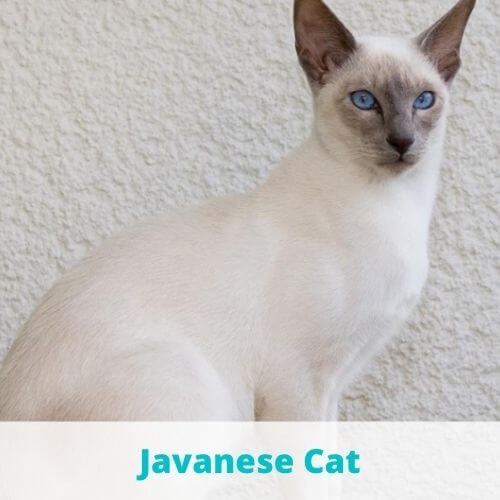
Javanese Cats are medium-sized cats with long, athletic bodies. Despite their name, they are not native to Java. Bred in North America, Javanese cats belong to the Siamese-like group.
A man-made breed, Javanese cats were meant to blend the personality of Siamese cats with a custom coat.
Its line includes various cat species: Balinese, Colorpoint Shorthair, Oriental Longhair, and Oriental Shorthair.
The Javanese cat has a semi-long, soft, silky coat, which makes it the ideal companion for people who suffer from allergies. There are 24 different colour variations.
Its head resembles a long triangle. With a lean and graceful silhouette, the Javanese Cat’s tail resembles a plume.
Despite their apparent delicacy, Javanese cats are outstanding athletes. They are very active and love to climb and jump.
This breed is very vocal, meowing until their needs get attended to. Good-natured and loving, Javanese cats love to snuggle and don’t mind the company of other pets.
Javanese cats are gourmands; if you own one, you need to pay special attention to their diet and exercise program. Otherwise, overweight might become a problem.
Interesting facts Javanese Cats
- Javanese cats are very intelligent. They can be trained to perform tricks, walk on a leash, open doors and drawers, etc.
- Since they are skilled jumpers, Javanese cats are sure to enjoy big cat trees.
14. Jack Russell Terrier

Bred in England during the 19th century by Reverend Jack Russell, Jack Russell Terriers are a working breed developed for fox hunting. They are baying terriers.
That means that they would chase foxes out of their burrows with their barking but without killing them.
Jack Russell terriers are energetic, vocal, and extremely curious. Not even training can eliminate completely their hunting instinct. That means that this breed sees cats and hamsters as prey.
Undoubtedly, this breed was made for outdoor adventures. Jack Russell Terriers are the ideal companion for long runs on rough terrains.
Jack Russell terriers’ coat can be broken, smooth, or rough. And all of them shed! Jack Russell terriers are white and have black or tan markings.
Alert, smart, and curious, these dogs make excellent watchdogs. But they require constant physical and intellectual stimulation, as well as early training.
Since they are unable to sit quietly, they can wreck the house when bored.
Interesting facts about Jack Russell Terriers
- Due to their intelligence, Jack Russell terriers can easily learn complex tricks. Hence, they make excellent canine actors.
- They can jump up to 2m in the air!
- Since they were bred to flush out foxes from their burrows, they love to dig.
- Since they shed a lot, Jack Russell terriers require regular grooming. However, excessive bathing is not recommended as it would dry their skin and make them shed more.
15. Jerusalem Cricket
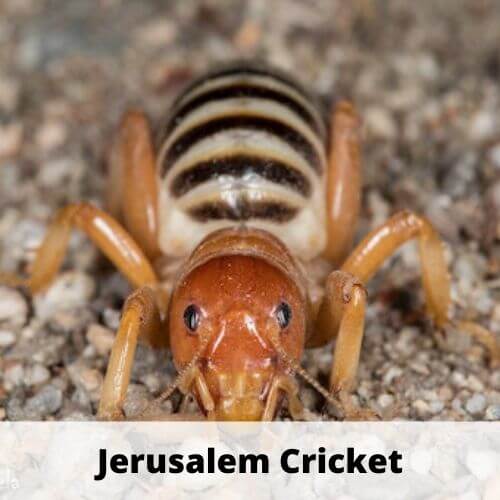
Related to grasshoppers, Jerusalem crickets can be found in Mexico, Western U.S., and semi-arid and dry climates all over the world.
Due to their fearsome appearance, Jerusalem crickets have inspired fear and superstition alike.
What’s more, this insect has a horrible odour. Jerusalem crickets are reddish-brown, have six legs, a segmented body, antennae, thick legs, and a striped abdomen.
But what makes them stand out is their head: smooth, round, and very large (if compared with the rest of the body).
They have strong mandibles and dark eyes that peer out. Since they have no ears, they communicate through vibrations (especially during the mating season to attract partners).
Jerusalem crickets are nocturnal and spend most of their life underground. They feed mainly on roots, tubers, and other small insects.
Since they eat insects, they help keep their population under control and also foster soil aeration and nutrients recycling.
Their biggest enemies are bats, foxes, coyotes, birds, skunks, badgers, and other nocturnal animals.
Interesting facts about Jerusalem Crickets
- They only bite when disturbed. Since they have strong jaws, their bite can be painful and can cause sores and rashes. However, it is not venomous.
- After mating, the female eats the male.
- They need 2 years to become adults.
- Despite being also commonly known as the potato bug, the Jerusalem cricket is not a bug. And it doesn’t eat potatoes either.
16. Jumping Spider
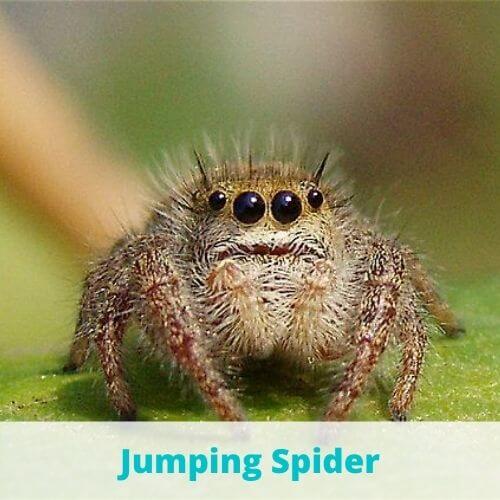
With more than 6.200 species found all around the world (except South and North Poles), Jumping spiders are actually the largest group of spiders.
Mainly found in tropical forests, jumping spiders come in a wide range of sizes, shapes, and colours.
As their name suggests, jumping spiders can make amazing leaps. To propel themselves, jumping spiders change the blood flow in their bodies, increasing the blood flow in their legs.
By doing so, the legs extend and allows them to jump as far as 50 times their bodies’ length. However, they do like security.
As they jump, jumping spiders spin lines of silk that not only provide direction but also allow them to ensure a smooth landing.
The jumping spider has impressive eyesight. It has 4 sets of eyes: two large eyes in front and a smaller eye on each side.
On top of its head, it has two medium-sized eyes and a smaller eye on each side. The smaller eyes ensure a wide-angle view, while the larger eyes provide amazing details in colour.
What’s more, their retinas can rotate on their own. That means that the spider doesn’t need to move its head to look around.
Jumping spiders don’t have ears. But they do have great hearing thanks to the sensory hairs that receive vibrations and send signals to their brain.
Jumping spiders don’t use webs to catch their prey. They simply jump on it. However, they do spin shelters to protect themselves from predators and bad weather.
Interesting facts about the Jumping Spider
- To impress their mating partners, males sing and … dance. They wave their legs in the air and beat their abdomens and tap their feet on the ground. The sensory hairs on the female’s legs perceive the vibrations. As for the singing, males buzz, click, and tap.
- The Myrmarachne melanocephala species is famous for its disguising abilities. These spiders manage to fool their prey and predators by mimicking ants!
17. Jacamar
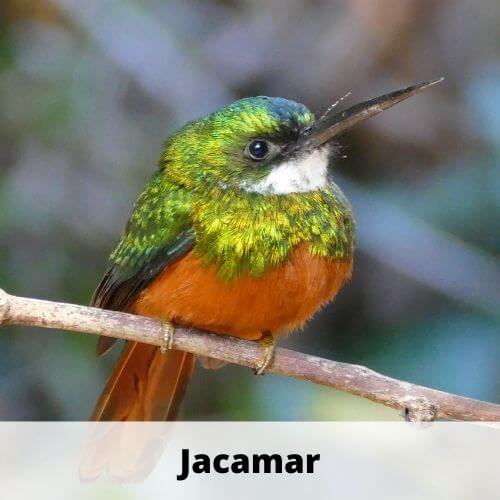
Native to South and Central America, jacamars are small to medium-sized perch birds.
Jacamars mainly inhabit low-altitude forests and woodlands. The jacamar family consists of 5 genera and 18 species. Jacamars have long bills, mall feet, and rounded wings.
While some species boast brightly, metallic coloured plumage, other species have a rather dull colouring. They have slender bodies that can vary in size. The most common specimens are small and medium-sized.
Generally, males have white throats, while the females’ are beige. Immature specimens can be distinguished by their smaller tails and beaks and their opaque hues.
Jacamars feed mainly on flying insects, moths, and butterflies which they capture in flight.
During its courtship, the male offers food to the female. The male and the female then dig a burrow and build a nest at the centre. Once the female lays the eggs, both parents incubate them.
Interesting facts about Jacamars
- After catching their prey, jacamars hit it against perches. By doing so, the prey loses its wings and can no longer escape.
- The Great Jacamar is the only species that eats lizards and spiders.
18. Jaeger
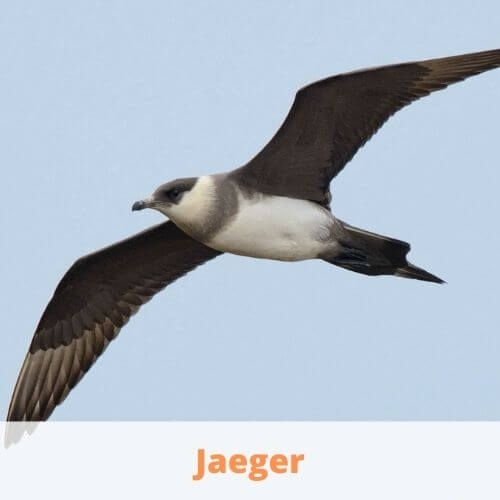
Jaegers are seabirds that belong to the skua family. Related to gulls, waders, and skimmers, there are three species: the parasitic Jaeger, the long-tailed Jaeger, and the Pomarine jaeger. Jaegers can be all-brown or brown and white.
Jaegers are rapacious birds and are famous for stealing food from other seabirds.
However, they also hunt for prey. Their diet can vary depending on the area they live in. But they mainly feed on fish, insects, small mammals, and other birds’ eggs and chicks.
Jaegers nest in the Arctic tundra and fly south in winter, some of them as far as Australia or New Zealand.
Jaegers are monogamous. During the mating season, the couple establishes a territory that the male will protect against predators. The female lays 1-2 eggs and incubates them. However, the male provides care to the chicks as well.
Interesting facts about Jaegers
● Jaegers are kleptoparasites. That means that they often steal other birds’ food. In fact, they chase and harass other birds until they regurgitate their meal!
● Jaegers breed in the Arctic Circle. However, they won’t hesitate to skip a year if the conditions are very harsh or there isn’t enough food.
● If the Jaeger’s partner dies, it won’t breed that year.
19. Jacana

Native to Africa, Australia, Asia, and the Americas, Jacanas are colourful water birds that are also known as lily-trotters or Jesus birds. And there is a good reason for it: they use their long legs, toes, and claws to walk on water.
Well, they actually walk on floating vegetation, especially lily pads. But they do make an impression!
Their long toes not only help them distribute weight and walk easily from one area to another but also turn over plants in search of food.
Jacanas spend most of their life on these improvised floating islands, building their nests and foraging.
Their diet consists of seeds, insects, worms, snails, larvae, mollusks, and other aquatic insects and arthropods.
Their biggest enemies are crocodiles, birds of prey, water snakes, others, and large fish. If a predator is near, jacanas send noisy alarms.
Jacanas are excellent swimmers and divers. To avoid predators, they will swim underwater. In exchange, they are very poor fliers, flying only on short distances.
Interesting facts about Jacanas
- Jacana chicks are precocial. Only a few hours after hatching, they are already able to swim, dive, and walk. The father will teach them to forage immediately. If in danger, chicks will dive and swim as well as their parents.
- When it comes to mating, jacanas are rather peculiar. Each female mates with several males and lays eggs in the males’ nest. From that point on, the male is in charge of everything: from nesting to caring for the chicks. Since they are larger than males, females will protect the territory against predators and other females.
- The nests are basically floating islands, partially submerged.
20. Jico deer mouse
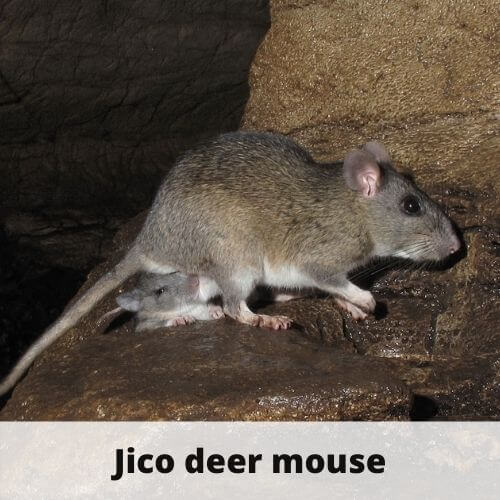
Listed as endangered species, the Jico deer mouse is a rodent that can be found exclusively in Mexico.
It inhabits subtropical and tropical moist lowlands and forests. An adult Jico deer mouse only weighs 40g! Unfortunately, little more is known about this species.
21. John Dory

If we can say one thing about John Dory, it’s that it’s called one of the ugliest fishes in the ocean, why? We’re not really sure, but look at the picture and judge for yourself.
You can find the John Dory fish in the oceans around Europe where the fish likes to swim close to the ocean floors.
The fish usually weighs around 12 pounds and can reach 2 feet long and live to be around 12 years.
You can recognize the John Dory by it has a black dot on each side of his body.
Interesting facts about John Dory
- John Dories have two dorsal fins, which is very unusual for fish
- The fish often bury themselves in the sand at the bottom of the ocean and rarely go up to the surface
- The official name of John Dory is Zeus Faber
22. Japanese Squirrel

Obviously by its name, you can imagine that this squirrel is native to the country of Japan.
Overall you will not know this specific species is the Japanese squirrel as it looks just like any other squirrel.
The main differences is the black eyes and bushy tail.
It’s going to be hard to ignore this little fellow when you come across it if you’re traveling in Japan.
Interesting facts about Japanese Squirrels
- The Japanese Squirrel has an amazing memory and can remember places he hides his food.
23. Jackson Chameleon

This animal actually looks more like an alien or a fictional character from a movie and not a real animal based on earth.
The three horns on his face is the most distinctive feature and also the fact that like other chameleon it can camouflage itself pretty darn good.
Why do I think about Godzilla when I look at this animal? It’s the horns.
Interesting facts about Jackson Chameleon
- The eggs of the Jackson Chameleon hatch in the belly of the mother and are actually born alive.
There you have it, this was our list of 23 animals that start with J and if you liked it make sure to read more of our animal lists:
